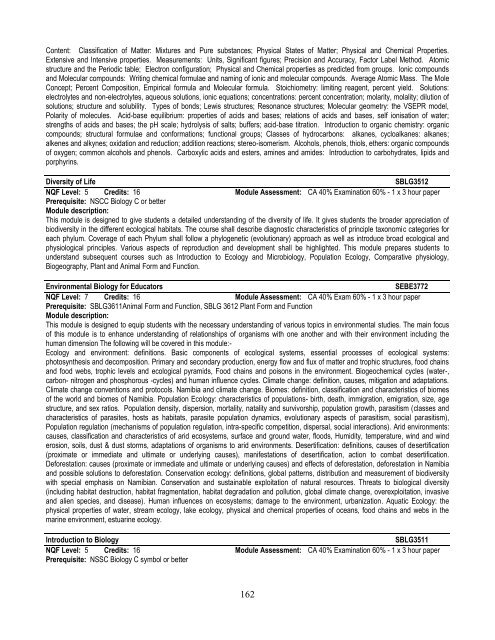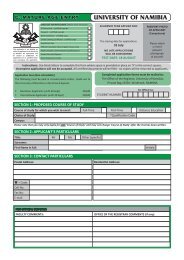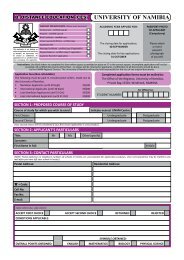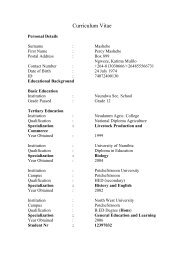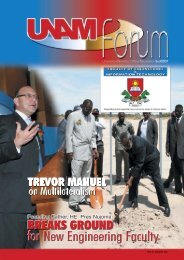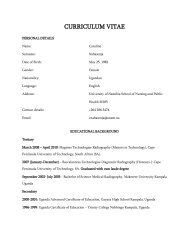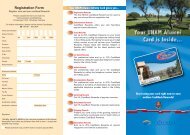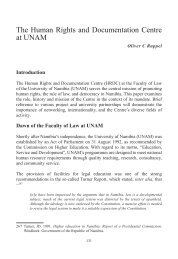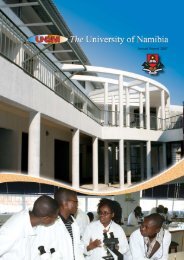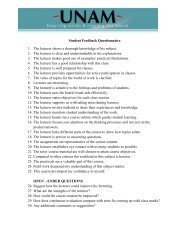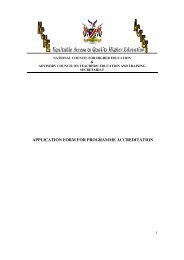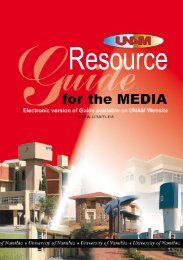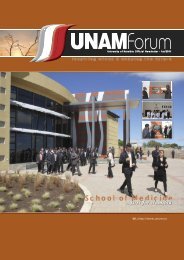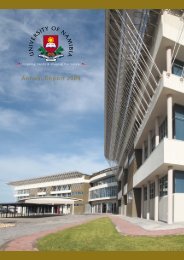UNIVERSITY OF NAMIBIA CENTRE FOR EXTERNAL STUDIES ...
UNIVERSITY OF NAMIBIA CENTRE FOR EXTERNAL STUDIES ...
UNIVERSITY OF NAMIBIA CENTRE FOR EXTERNAL STUDIES ...
You also want an ePaper? Increase the reach of your titles
YUMPU automatically turns print PDFs into web optimized ePapers that Google loves.
Content: Classification of Matter: Mixtures and Pure substances; Physical States of Matter; Physical and Chemical Properties.Extensive and Intensive properties. Measurements: Units, Significant figures; Precision and Accuracy, Factor Label Method. Atomicstructure and the Periodic table; Electron configuration; Physical and Chemical properties as predicted from groups. Ionic compoundsand Molecular compounds: Writing chemical formulae and naming of ionic and molecular compounds. Average Atomic Mass. The MoleConcept; Percent Composition, Empirical formula and Molecular formula. Stoichiometry: limiting reagent, percent yield. Solutions:electrolytes and non-electrolytes, aqueous solutions, ionic equations; concentrations: percent concentration; molarity, molality; dilution ofsolutions; structure and solubility. Types of bonds; Lewis structures; Resonance structures; Molecular geometry: the VSEPR model,Polarity of molecules. Acid-base equilibrium: properties of acids and bases; relations of acids and bases, self ionisation of water;strengths of acids and bases; the pH scale; hydrolysis of salts; buffers; acid-base titration. Introduction to organic chemistry: organiccompounds; structural formulae and conformations; functional groups; Classes of hydrocarbons: alkanes, cycloalkanes: alkanes;alkenes and alkynes; oxidation and reduction; addition reactions; stereo-isomerism. Alcohols, phenols, thiols, ethers: organic compoundsof oxygen; common alcohols and phenols. Carboxylic acids and esters, amines and amides: Introduction to carbohydrates, lipids andporphyrins.Diversity of LifeSBLG3512NQF Level: 5 Credits: 16 Module Assessment: CA 40% Examination 60% - 1 x 3 hour paperPrerequisite: NSCC Biology C or betterModule description:This module is designed to give students a detailed understanding of the diversity of life. It gives students the broader appreciation ofbiodiversity in the different ecological habitats. The course shall describe diagnostic characteristics of principle taxonomic categories foreach phylum. Coverage of each Phylum shall follow a phylogenetic (evolutionary) approach as well as introduce broad ecological andphysiological principles. Various aspects of reproduction and development shall be highlighted. This module prepares students tounderstand subsequent courses such as Introduction to Ecology and Microbiology, Population Ecology, Comparative physiology,Biogeography, Plant and Animal Form and Function.Environmental Biology for EducatorsSEBE3772NQF Level: 7 Credits: 16 Module Assessment: CA 40% Exam 60% - 1 x 3 hour paperPrerequisite: SBLG3611Animal Form and Function, SBLG 3612 Plant Form and FunctionModule description:This module is designed to equip students with the necessary understanding of various topics in environmental studies. The main focusof this module is to enhance understanding of relationships of organisms with one another and with their environment including thehuman dimension The following will be covered in this module:-Ecology and environment: definitions. Basic components of ecological systems, essential processes of ecological systems:photosynthesis and decomposition. Primary and secondary production, energy flow and flux of matter and trophic structures, food chainsand food webs, trophic levels and ecological pyramids, Food chains and poisons in the environment. Biogeochemical cycles (water-,carbon- nitrogen and phosphorous -cycles) and human influence cycles. Climate change: definition, causes, mitigation and adaptations.Climate change conventions and protocols. Namibia and climate change. Biomes: definition, classification and characteristics of biomesof the world and biomes of Namibia. Population Ecology: characteristics of populations- birth, death, immigration, emigration, size, agestructure, and sex ratios. Population density, dispersion, mortality, natality and survivorship, population growth, parasitism (classes andcharacteristics of parasites, hosts as habitats, parasite population dynamics, evolutionary aspects of parasitism, social parasitism),Population regulation (mechanisms of population regulation, intra-specific competition, dispersal, social interactions). Arid environments:causes, classification and characteristics of arid ecosystems, surface and ground water, floods, Humidity, temperature, wind and winderosion, soils, dust & dust storms, adaptations of organisms to arid environments. Desertification: definitions, causes of desertification(proximate or immediate and ultimate or underlying causes), manifestations of desertification, action to combat desertification.Deforestation: causes (proximate or immediate and ultimate or underlying causes) and effects of deforestation, deforestation in Namibiaand possible solutions to deforestation. Conservation ecology: definitions, global patterns, distribution and measurement of biodiversitywith special emphasis on Namibian. Conservation and sustainable exploitation of natural resources. Threats to biological diversity(including habitat destruction, habitat fragmentation, habitat degradation and pollution, global climate change, overexploitation, invasiveand alien species, and disease). Human influences on ecosystems; damage to the environment, urbanization. Aquatic Ecology: thephysical properties of water, stream ecology, lake ecology, physical and chemical properties of oceans, food chains and webs in themarine environment, estuarine ecology.Introduction to BiologySBLG3511NQF Level: 5 Credits: 16 Module Assessment: CA 40% Examination 60% - 1 x 3 hour paperPrerequisite: NSSC Biology C symbol or better162


